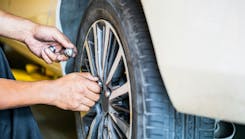Tech Tip: What to do when a brake stroke is out of adjustment
The experts at Bendix Commercial Vehicle Systems LLC recognize that proper brake stroke adjustment and maintenance are critical to commercial vehicle and roadway safety. As part of its newly released Bendix Tech Tips series, Bendix reminds vehicle owners of its clear, step-by-step guidelines for addressing out-of-adjustment wheel-ends equipped with automatic slack adjusters.
"During the Commercial Vehicle Safety Alliance (CVSA)-sponsored Roadcheck inspections in June, approximately 3,700 vehicles in the United States and Canada were removed from service due to brakes out of adjustment," said Mark Kromer, chief engineer, actuation/slack adjuster products, Bendix Spicer Foundation Brake LLC (BSFB). "It's a stark illustration of the importance of including brake stroke measurement in any pre-trip wheel-end inspection."
To measure the chamber stroke on each wheel-end, Bendix typically recommends checking the distance from the chamber to the pin with the brakes released, and again after a full brake application. The difference between the two measurements is the chamber stroke. Check the CVSA guidelines to determine the maximum allowable stroke, which is based on the chamber size and type.
Wheel-ends beyond the maximum allowable stroke are considered out of adjustment. Under CVSA inspection guidelines, drivers can incur fines if 25 percent of a truck's wheel-ends are out of adjustment.
If a wheel-end equipped with an automatic slack adjuster is out of adjustment, Bendix's first – and most important – piece of advice is this: Do not manually adjust the adjuster. There are many factors that can cause an automatic slack adjuster to overstroke, but none of these will be remedied with a manual readjustment.
Instead, investigate why the brake is over the stroke limit.
Start by referring to the manufacturer's instructions and mechanism tests to determine whether the slack adjuster is properly adjusting the brake. (For example, the Bendix Versajust slack adjuster test is described on page 6 of the product Service Data Sheet.) Also check the manufacturer's recommendations for lubrication of the adjuster, noting the suggested mileage, frequency, and lubricant grade. (Bendix recommends using an NGLI grade 2 lubricant at every preventive maintenance inspection, which is approximately every three months or 30,000 miles.)
Once the automatic slack adjuster itself has been inspected, use the following checklist to examine other wheel-end components and fix any situations that can lead to overstroke. Where component replacement is necessary, Bendix stresses the use of OEM-equivalent equipment to ensure correct operation and peak performance.
- Check for proper lubrication of the brake camshaft and cam tube.
- Inspect the cam head and rollers for abnormal wear.
- Evaluate the brake's friction blocks for wear level and cracks, replacing the friction if necessary.
- Inspect the camshaft bushings for wear by checking radial and axial endplay, following the brake manufacturer's guidelines. If necessary, replace the bushings.
- Check the brake drums for maximum diameter and surface finish, and replace if necessary.
- Check the brake shoe return springs to ensure a proper return to the "zero stroke" position.
- Inspect the return spring on the air chamber or on the service side of double diaphragm spring brakes.
- Inspect the clevis pins connecting the chamber to the automatic slack adjuster to ensure they turn freely and are coated with an anti-seize lubricant.
Upon completing these inspections, verify the slack adjuster's performance by following the manufacturer's instructions on conducting a functional check.
"Properly installed and maintained automatic slack adjusters should never need adjusting after the initial setup," Kromer said. "Brake stroke has a direct impact on braking performance, and maintaining proper adjustment is vital to keeping commercial vehicles operating safely. Technicians, fleets, and drivers should not hesitate to contact manufacturers directly with any questions about their slack adjusters – everyone's highway safety is on the line."
Information provided by: Bendix Commercial Vehicle Systems LLC

